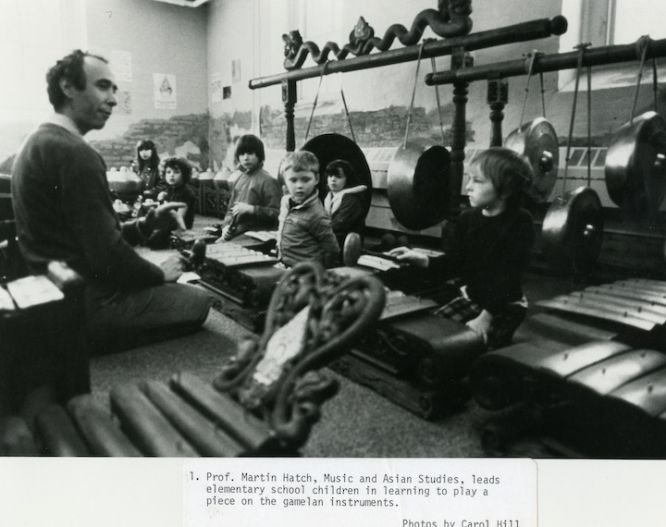Bridging Worlds, Connecting Communities: A History of SEAP Outreach, the Early Years

by Brenna Fitzgerald, SEAP Communications and Outreach Coordinator
As featured in the Spring 2021 SEAP Bulletin, this article recounts the early years of SEAP Outreach with its mission to share Southeast Asian culture with local educators and the community at large, beginning in the 1970s.
The idea of outreach for SEAP—before it was defined as such and turned into a formal office in 1977—was initially intended to address the dissemination of knowledge about countries, cultures, and languages of Southeast Asia. In the early 1970s, faculty appeared at national conferences, on TV and radio, and at local community colleges. They served as business and cultural advisors, especially on politics and economics in Southeast Asia. In these early years, the John [BEF1] M. Echols Collection on Southeast Asia—one of the largest of its kind—became available to the non-Cornell community, including local junior and senior high school and community college educators and students.
SEAP has received Title VI funding every year from the US Department of Education in the form of a National Resource Center (NRC) grant since 1960. For the first ten years of its growth, these funds were mostly allocated to building language and course offerings, in an effort to train scholars, and also to growing library acquisitions, quickly establishing SEAP at Cornell as one of the top Southeast Asia area studies programs in the country. Outreach, now carried out with significant Title VI funding, was not mentioned in any of the early grants until the 1970s, when the Department of Education began to ramp up the importance of relationships with the community in NRC grant priorities.
Indeed, in the early 1970s, as the Vietnam War raged on and as Southeast Asia became front and center in the national and international consciousness, SEAP received increasing requests from various communities for knowledge about the cultures and countries of Southeast Asia. These requests came primarily from the US government, other universities and local community colleges, K-12 schools, and a range of organizations in the upstate New York Finger Lakes region, which was increasingly becoming home to many refugees from Vietnam, Cambodia, and Laos.
In 1973, Cornell opened the Herbert F. Johnson Museum of Art, which soon became a major resource for the public as well as a vehicle for SEAP to share Southeast Asian culture with a wider audience. SEAP faculty collaborated with the [BEF2] museum to offer talks and curated exhibitions open to the public. Around this same time, Harrison Parker, a Cornellian working in Indonesia for the State Department, brought back enough musical instruments to form two gamelan ensembles at Cornell after his time working at the embassy. The first official gamelan was set up in Risley Hall, and SEAP used gamelan performances on campus as a vehicle to get people interested in and engaging with Southeast Asia.
According to Martin F. Hatch, professor emeritus, who received his PhD in music from Cornell in 1971 and eventually took over as director of the Cornell Gamelan Ensemble in 1980, “outreach plays a role in keeping people engaged and brings out the strengths and vitality of a place.” He noted that gamelan became the perfect outreach tool early on, because this performance art is “immediately accessible and more directly tied to Southeast Asian ‘practice’—namely, to what (some) Southeast Asians actually DO, and what many ‘LIKE’ . . . It isn’t mediated through the mind of someone else—the words/works of an authority on the subject . . . and delivers something much closer to the Southeast Asian experience, to Southeast Asian culture in practice.”[i]
In the early 1970s, while Marty was intimately involved in building the Cornell Gamelan Ensemble and coordinating performances all over New York State, outreach became more than just simply disseminating knowledge. In tandem with new Department of Education priorities, SEAP shifted focus to community impact through sustained engagement and recognized the need for a staff member fully devoted to this mission.
The first SEAP outreach coordinator, Dr. William J. O’Mally (Bill), appointed to the newly created position in February of 1977, was a fellow graduate student with Marty. Bill received his PhD in Southeast Asian history and government, working under Professor George Kahin, and was familiar with SEAP’s resources and policies. From the time of his appointment until June 1977, Bill concentrated his efforts on planning and developing a comprehensive program of outreach activities in consultation with instructors at nearby institutions and SEAP faculty. Target audiences for outreach collaborations included local high schools, regional colleges and universities, and the community at large. READ MORE
[i] Martin F. Hatch, Zoom interview by author, December 9, 2020.
